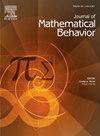网络理论的定量推理和数学推理探索学生对函数的理解
IF 1.7
Q3 EDUCATION & EDUCATIONAL RESEARCH
引用次数: 0
摘要
本研究考察中学生在解决功能关系模型任务时的推理过程。它将定量推理(QR)和数学推理(MR)的理论联系起来,通过比较和对比,同时协调和结合协变推理(CR)和MR,来研究学生在一个定量丰富的问题解决过程中对函数的理解。这项分析利用了一项涉及8名参与者的小规模教学实验的数据。心理行动1-2阶段的学生主要依赖于记忆策略和表面属性,导致僵化的程序性反应。特别是,学生经常调用图形形式和符号约定——例如图形的视觉形状或代数模板——作为函数类型的固定提示。这种形状思维和惯例的使用加强了模仿推理,因为学生们应用了熟悉的模式,而没有分析潜在的定量关系。相反,展示心理行为3-5的学生表现出创造性推理,深入参与共变关系来构建有充分支持的数学论点。本研究强调了CR和模仿推理之间的双向关系,表明对程序性策略的依赖源于有限的概念理解,并使其持续存在。本文章由计算机程序翻译,如有差异,请以英文原文为准。
Networking theories of quantitative reasoning and mathematical reasoning to explore students’ understanding of functions
This study examines the reasoning processes of secondary school students while they solve tasks that model functional relationships. It networks theories of quantitative reasoning (QR) and mathematical reasoning (MR) by comparing and contrasting while also coordinating and combining covariational reasoning (CR) with MR to investigate students’ understanding of functions within a quantitatively rich problem-solving process. The analysis draws on data from a small-scale teaching experiment involving eight participants. Students operating at Mental Actions 1–2 primarily relied on memorized strategies and surface-level properties, leading to rigid, procedural responses. In particular, students often invoked graphical forms and symbolic conventions—such as the visual shape of a graph or algebraic templates—as fixed cues for function type. This use of shape thinking and conventions reinforced imitative reasoning, as students applied familiar patterns without analyzing underlying quantitative relationships. Conversely, students demonstrating Mental Actions 3–5 exhibited creative reasoning, engaging deeply with covarying relationships to construct well-supported mathematical arguments. This study underscores the bidirectional relationship between CR and imitative reasoning, suggesting that reliance on procedural strategies both arises from and perpetuates limited conceptual understanding.
求助全文
通过发布文献求助,成功后即可免费获取论文全文。
去求助
来源期刊

Journal of Mathematical Behavior
EDUCATION & EDUCATIONAL RESEARCH-
CiteScore
2.70
自引率
17.60%
发文量
69
期刊介绍:
The Journal of Mathematical Behavior solicits original research on the learning and teaching of mathematics. We are interested especially in basic research, research that aims to clarify, in detail and depth, how mathematical ideas develop in learners. Over three decades, our experience confirms a founding premise of this journal: that mathematical thinking, hence mathematics learning as a social enterprise, is special. It is special because mathematics is special, both logically and psychologically. Logically, through the way that mathematical ideas and methods have been built, refined and organized for centuries across a range of cultures; and psychologically, through the variety of ways people today, in many walks of life, make sense of mathematics, develop it, make it their own.
 求助内容:
求助内容: 应助结果提醒方式:
应助结果提醒方式:


